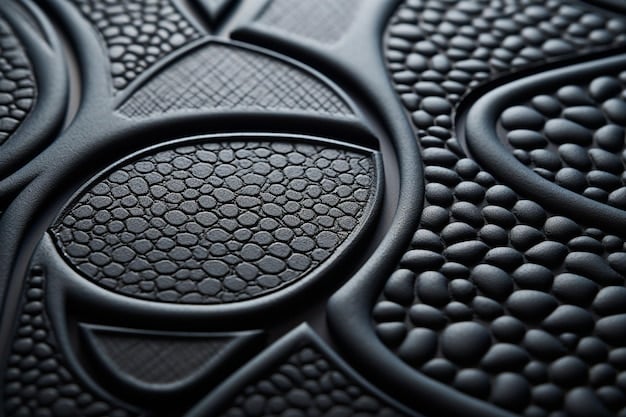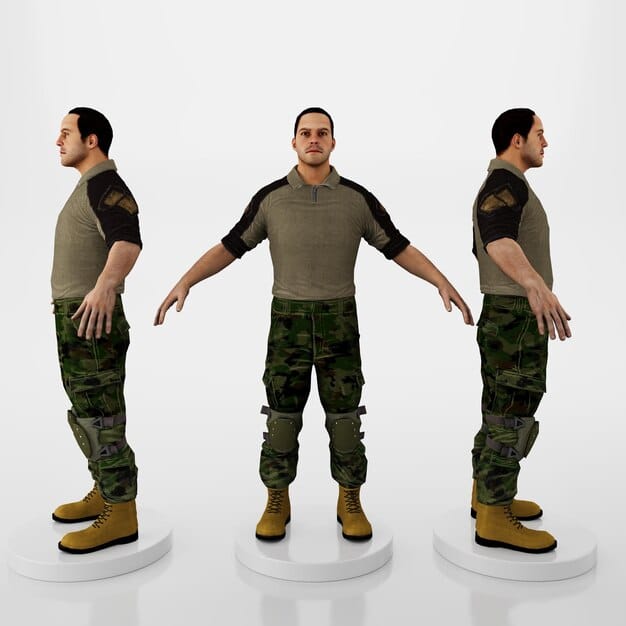Next-Generation Body Armor: Lightweight Ballistic Protection Advancements

Next-generation body armor leverages advanced materials and designs to provide enhanced, lightweight ballistic protection for military personnel, law enforcement, and civilians, addressing the evolving threats on modern battlefields and urban environments.
The landscape of personal protective equipment is constantly evolving, driven by the need for greater safety and mobility in high-risk environments. A critical area of innovation is in next-generation body armor, where advancements in materials science and engineering are leading to lighter, more effective ballistic protection. This article delves into the technological breakthroughs that are shaping the future of body armor.
What are the key factors driving the development of next-generation body armor? How are these advancements enhancing the safety and effectiveness of those who rely on it? Let’s explore the innovative materials and designs that are setting new standards in ballistic protection.
Examining the Evolution of Body Armor Technology
Body armor has come a long way from its early iterations of metal plates and chainmail. Today’s technology focuses on providing maximum protection with minimal weight and bulk. The evolution of body armor is a story of continuous improvement and innovation, driven by the need to counter ever-evolving threats.
From Steel to Synthetics: A Material Revolution
The shift from heavy steel plates to lighter, more flexible synthetic materials has been a game-changer in body armor technology. This transition has significantly improved mobility and comfort without compromising protection.
- Kevlar: One of the earliest and most widely used synthetic materials, Kevlar offers excellent tensile strength and ballistic resistance.
- Spectra: Ultra-high-molecular-weight polyethylene (UHMWPE) fibers, like Spectra, provide superior strength-to-weight ratios compared to traditional materials.
- Composite Materials: Combining different materials, such as ceramics and polymers, allows for the creation of armor that can defeat a wider range of threats.

In conclusion, the evolution of materials used in body armor has been pivotal in enhancing protection and comfort. The development and integration of advanced synthetics and composite materials are at the forefront of next-generation body armor.
Next-Generation Body Armor: Examining the Technological Advancements in Lightweight Ballistic Protection
Next-generation body armor: Examining the technological advancements in lightweight ballistic protection requires a deep understanding of material science, engineering, and threat assessment. These cutting-edge armors are designed to provide superior protection against a wide range of projectiles while maintaining maximum agility and comfort for the wearer.
Advanced Materials and Their Protective Properties
The core of next-generation body armor lies in the advanced materials used in its construction. These materials are engineered to dissipate energy and prevent penetration from high-velocity projectiles, enhancing ballistic protection capabilities.
- Ceramic Plates: Often used in conjunction with other materials, ceramic plates are highly effective at shattering projectiles and dispersing energy.
- Graphene: This single-layer carbon material is incredibly strong and lightweight, offering potential for future body armor applications.
- Shear-Thickening Fluids: These fluids transform from a liquid to a solid upon impact, providing an additional layer of protection against high-energy threats.
By carefully selecting and combining these advanced materials, manufacturers can create body armor that offers unparalleled protection without sacrificing mobility. Next-generation body armor: examining the technological advancements in lightweight ballistic protection is a continuous pursuit of innovation in this field.
The Role of Nanotechnology in Future Body Armor
Nanotechnology is playing an increasingly significant role in the development of advanced body armor. By manipulating materials at the nanoscale, scientists can create armor with enhanced strength, flexibility, and impact resistance. The potential applications of nanotechnology in this field are vast and promising.
Nanomaterials for Enhanced Strength and Durability
Nanomaterials offer unique properties that can significantly improve the performance of body armor. These materials can be incorporated into existing armor designs or used to create entirely new types of protective gear.
- Carbon Nanotubes: These cylindrical structures possess exceptional strength and stiffness, making them ideal for reinforcing body armor materials.
- Nanoclay Composites: Adding nanoclay particles to polymers can enhance their mechanical properties and improve their resistance to impact.
- Self-Assembling Peptides: These molecules can form organized structures that provide enhanced protection against ballistic threats.
The integration of nanomaterials into body armor represents a significant step forward in personal protective equipment technology. The ongoing research and development in this area promise to yield even more advanced and effective solutions in the future. The use of nanotechnology can greatly improve next-generation body armor performance.
Designing for Mobility and Comfort
While protection is paramount, mobility and comfort are also critical considerations in the design of next-generation body armor. Armor that is too bulky or restrictive can hinder movement and reduce the wearer’s effectiveness. Therefore, designers are constantly seeking ways to optimize the fit and feel of body armor.
Ergonomic Design Principles
Applying ergonomic design principles helps to create body armor that conforms to the wearer’s body and allows for a full range of motion. This includes considering the placement of armor plates, the distribution of weight, and the use of flexible materials.
- Modular Designs: Modular body armor systems allow users to customize their level of protection based on the specific threat environment.
- Breathable Materials: Incorporating breathable fabrics and ventilation systems helps to regulate body temperature and reduce moisture buildup.
- Adjustable Straps and Closures: Adjustable straps and closures ensure a secure and comfortable fit for a wide range of body types.

Designing for mobility and comfort is essential for ensuring that body armor is not only protective but also practical and user-friendly. Advances in ergonomic design are helping to create armor that is both effective and comfortable to wear.
Testing and Evaluation of Advanced Body Armor Systems
Rigorous testing and evaluation are essential for ensuring that next-generation body armor meets the required performance standards. These tests simulate real-world threat scenarios and assess the armor’s ability to withstand various types of projectiles. Standardized testing protocols are crucial for ensuring the safety and reliability of body armor systems.
Ballistic Testing Protocols and Standards
Ballistic testing involves firing projectiles at body armor samples under controlled conditions to determine their penetration resistance. These tests are conducted according to established standards, such as those developed by the National Institute of Justice (NIJ).
- NIJ Standards: The NIJ sets standards for ballistic resistance, stab resistance, and other performance characteristics of body armor.
- Third-Party Testing: Independent testing laboratories provide unbiased evaluations of body armor performance, ensuring compliance with industry standards.
- Live Fire Exercises: Live fire exercises simulate real-world combat scenarios and provide valuable feedback on the performance of body armor in realistic conditions.
Comprehensive testing and evaluation are critical for validating the effectiveness of advanced body armor systems. Regular testing helps to identify areas for improvement and ensures that body armor provides the highest possible level of protection. Examining the technological advancements in next-generation body armor requires continuous testing and refinement to make advances.
The Future of Lightweight Ballistic Protection
The future of lightweight ballistic protection is one of continuous innovation and improvement. As new materials and technologies emerge, body armor will become lighter, more effective, and more comfortable to wear. The ultimate goal is to provide the highest possible level of protection while minimizing the burden on the wearer. Technological advancements are paving the way forward.
Emerging Trends and Technologies
Several emerging trends and technologies are poised to shape the future of body armor. These include the development of self-healing materials, smart armor systems, and advanced manufacturing techniques. These advancements promise to revolutionize the field of personal protective equipment.
- Self-Healing Materials: These materials can repair themselves after being damaged, extending the lifespan and effectiveness of body armor.
- Smart Armor Systems: Integrating sensors and communication devices into body armor can provide real-time threat assessment and situational awareness.
- 3D Printing: Additive manufacturing techniques, such as 3D printing, allow for the creation of customized body armor designs tailored to individual users.
| Key Point | Brief Description |
|---|---|
| 🛡️ Material Evolution | Shift from steel to synthetics like Kevlar and Spectra. |
| 🔬 Nanotechnology | Use of nanomaterials for enhanced strength. |
| 🎽 Ergonomic Design | Focus on mobility and comfort with modular systems. |
| 🧪 Testing Protocols | Rigorous testing to meet NIJ standards. |
Frequently Asked Questions
Key materials include Kevlar, Spectra, ceramic plates, graphene, and shear-thickening fluids, each offering unique protective properties and contributing to enhanced ballistic resistance.
Nanotechnology improves body armor by utilizing nanomaterials like carbon nanotubes and nanoclay composites to enhance strength, durability, and impact resistance at the nanoscale.
Ergonomic design ensures that body armor is comfortable and allows for a full range of motion, improving the wearer’s effectiveness. This includes modular designs and breathable materials.
Body armor is tested according to standards set by the National Institute of Justice (NIJ), along with third-party testing and live fire exercises to ensure reliability.
Emerging trends include self-healing materials, smart armor systems with integrated sensors, and advanced manufacturing techniques like 3D printing for customized designs.
Conclusion
Next-generation body armor: Examining the technological advancements in lightweight ballistic protection reveals the continuous evolution of personal protective equipment. Through innovations in materials, design, and testing, body armor is becoming lighter, more effective, and more comfortable. These advancements promise a safer future for those who rely on ballistic protection.





